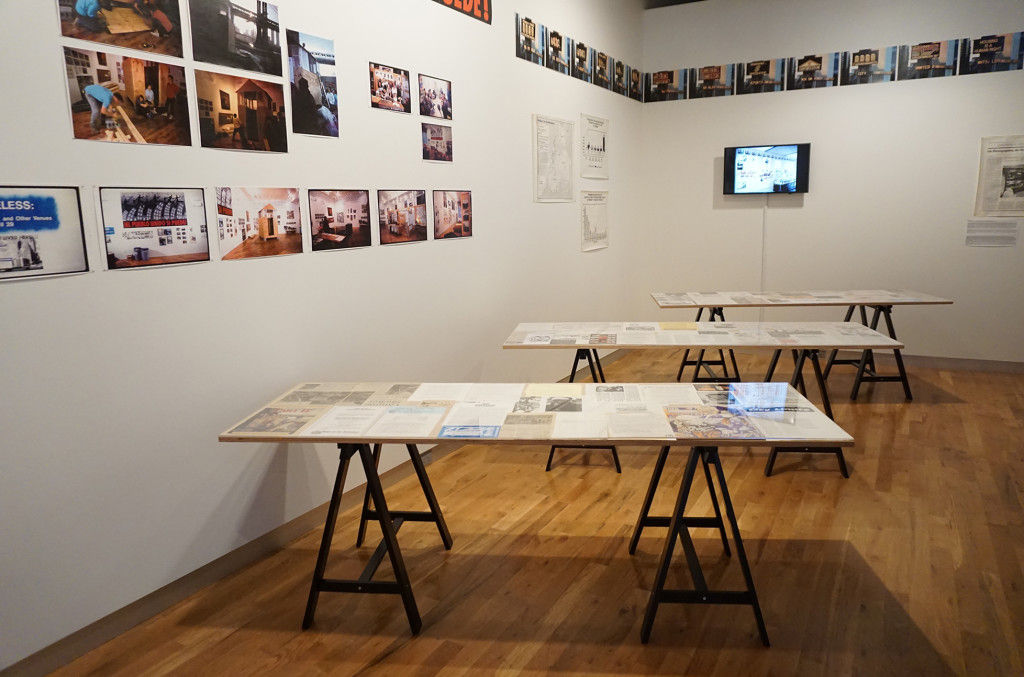Art is a form of activism. Martha Rosler demonstrates this in “Homelessness: The Street and Other Venues,” the final installment of a three-part exhibition called, “If You Lived Here Still,” which went on display last Thursday at New Foundation Seattle. The original exhibition, which first took place in New York City in 1989, included numerous flyers, posters, press releases, photographs, videotapes, magazine articles and newspaper clippings, as well as many items that informed Rosler as she did her research. Part research-based artwork, part curated group show, part roaming series that centers itself on the subject of homelessness in America, the show rings a note that is all too familiar for the people of Seattle.
“It’s clear that, with rapid growth in Seattle, there is a crisis with homeless,” said Yoko Ott, Founding Director of New Foundation Seattle.
Ott worked with Rosler to present her exhibit satisfactorily.
“I’ve never worked with someone with so much insight and precision. She’s a true New Yorker in that she don’t mince her words,” Ott said. “There is no gap between the art and the artist.”
A born New Yorker who lives and works in Brooklyn, Rosler has produced an array of work that addresses social issues through a mosaic of different mediums. Visitors of the exhibit will be privy to her eclectic artistic tastes through access to a small library, which includes documents from Rosler’s research archive along with books from her personal collection. From a wall-to-ceiling tapestry that visualizes the number of homeless people in King County to a video recording showing court cases and interviews with people on the street, all of Rosler’s work has a blindingly clear intersection: what it’s like to be homeless.
It’s appropriate for this kind of work to be displayed in Seattle, less than a year after Seattle Mayor Ed Murray declared a State of Emergency on homelessness. He made that declaration during a live speech he gave at Mary’s Place Family Center in North Seattle in November 2015.
“Too often we think about this as a Seattle problem with a Seattle solution. But this is a national tragedy. It should be a national emergency and it needs a national response,” Mayor Murray said during the same speech. “…The polarized, one-size-fits-all rhetoric we increasingly hear from both sides is unhelpful. So part of what I am asking today is that we challenge each other to do better without denigrating each other. Instead of cooperation and a shared voice, we have seen too much division and extreme rhetoric about who homeless people are and how to solve the crisis.”
At Seattle University, some students and faculty use their time to help shed light on homelessness as it affects the Seattle area. Catherine Hinrichsen, from the Communications and Journalism department in the College of Arts and Sciences, serves as the Family Homelessness Program Manager. As such, she has worked with numerous artists, activists and even journalists on an equally diverse repertoire of projects to help people understand the nature of this issue. There are many like her, throughout the city, who use unexpected means to express themselves: broadcast channels, theatre and other art forms are being used for more than display.
“Art gets to us emotionally in a way that facts don’t,” Hinrichsen said. “You can reach people where they least expect it.”
Six years ago, the Homelessness Program was awarded a fellowship grant by the Gates Foundation. They used the money to collaborate with local journalists to study homelessness in Seattle. Writers and reporters from The Seattle Times, Real Change and BBC, among other publications, worked together to publish several in-depth, investigative stories on the current state of housing in the city.
“There are so many ways to tell a story,” Hinrichsen said. “And to connect people to action as a result.”
Senior Lindsey Habenicht is one of the three Seattle U students who works with Hinrichsen in the Family Homelessness Program. She’s interested in studying the effects of homelessness on children and early brain development. Recalling when she became engaged in this issue, she remembers back when she worked at a soup kitchen and saw the many faces of homelessness, hungry and lost and how most people don’t know what they have to do to survive.
“I’m drawn to the stories [people] have and how they’re not shared,” Hebenicht said.
Rosler’s exhibit will be on display until May 28, after which its next destination is unknown. Presumably, it will move onto another city plagued by similar issues.
Nick may be reached at nturner@su-spectator.com









